JavaScript: Ajax & DOM Manipulation
Download as PPT, PDF33 likes8,990 views
JavaScript workshop for PSU Information Desk employees. Discusses JavaScript, Ajax, DOM Manipulation, jQuery, etc.
1 of 31
Downloaded 1,306 times
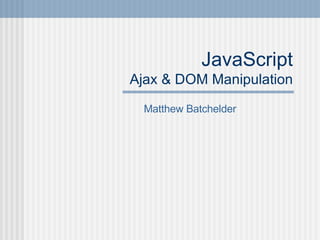
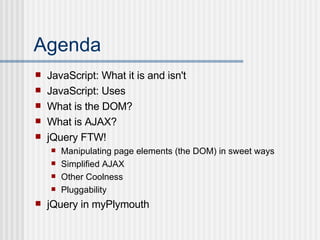
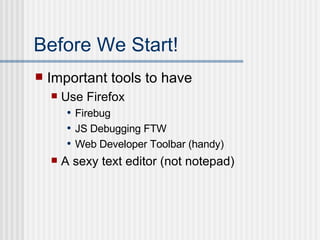

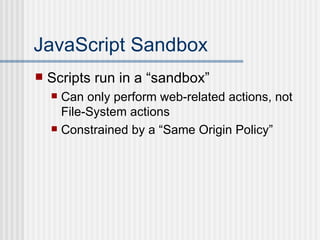

![JS: Literals The following are literalsˇeach variable is literally the data assigned. <script type=ˇ°text/javascriptˇ±> var myNumber = 123; var myString = ˇ®Bork!ˇŻ; var myBoolean = true; var myFunction = function(){ return ˇ®helloˇŻ;} var myRegExp = /bork/gi; var myArray = [1, 2, 3]; var myCarObject = { color: ˇ®redˇŻ, tires: 4, windows: 6 } </script>](https://image.slidesharecdn.com/javascript-ajax-dom-manipulation-1194831365260172-2/85/JavaScript-Ajax-DOM-Manipulation-7-320.jpg)
![JS: Objects Everything in JS is an Object Those literals can be written: <script type=ˇ°text/javascriptˇ±> var myNumber = new Number(123); var myString = new String(ˇ®Bork!ˇŻ); var myBoolean = new Boolean(true); var myFunction = new Function(ˇ®ˇŻ, ˇ°return ˇ®helloˇŻˇ±);} var myRegExp = new RegExp(ˇ®borkˇŻ); var myArray = new Array(); myArray[0] = 1; myArray[1] = 2; myArray[2] = 3; var myCarObject = new Object(); myCarObject.color = ˇ®redˇŻ; myCarObject.tires = 4; myCarObject.windows = 6; </script>](https://image.slidesharecdn.com/javascript-ajax-dom-manipulation-1194831365260172-2/85/JavaScript-Ajax-DOM-Manipulation-8-320.jpg)



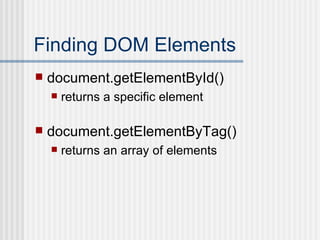



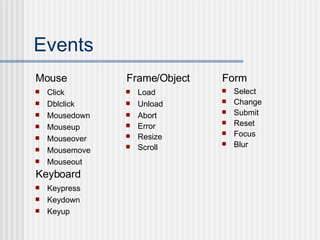

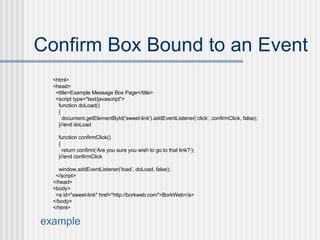

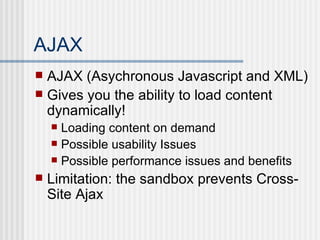



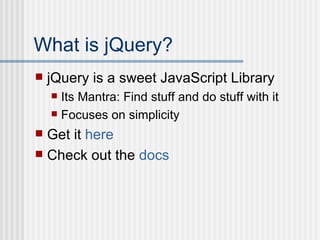

![Finding Elements With $ $(ˇ®aˇŻ) $(ˇ®.classˇŻ) $(ˇ®#idˇŻ) $(ˇ®.content divˇŻ) $(ˇ®input[name=bork]ˇŻ) $(ˇ®input:firstˇŻ) HereˇŻs an example . Check out the selector syntax for more info.](https://image.slidesharecdn.com/javascript-ajax-dom-manipulation-1194831365260172-2/85/JavaScript-Ajax-DOM-Manipulation-26-320.jpg)
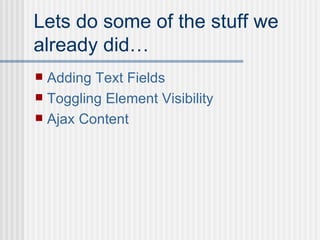




Recommended
Basics of JavaScript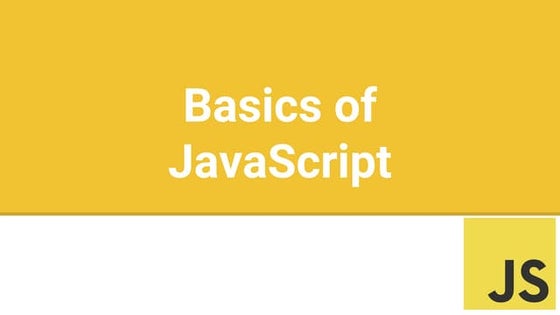



Basics of JavaScriptBala Narayanan
?
JavaScript is a scripting language originally designed for web browsers but now used everywhere. It has dynamic typing and supports object-oriented, imperative, and functional programming. JavaScript was created in 1995 and standardized in 1999. It is now the most popular language on GitHub. JavaScript can be used to build interactive web pages, desktop applications, server-side applications, IoT applications, and real-time applications. The core data types in JavaScript are Number, String, Boolean, Object, Function, Array, Date, and Regular Expressions. JavaScript supports features like variables, flow control, error handling, debugging, and JSON for data exchange.Basic Javascript



Basic JavascriptBunlong Van
?
This document provides an overview of basic Javascript concepts including data types, objects, arrays, functions, and the global object. It discusses key Javascript data types like numbers, strings, booleans, null, undefined and objects. It also covers object literals, arrays, functions as first class objects, closures, and the this keyword. The document emphasizes that functions have a special arguments parameter and functions can be methods within objects. It notes that the global object contains global variables and built-in objects and that global variables should be avoided.JavaScript - Chapter 13 - Browser Object Model(BOM)



JavaScript - Chapter 13 - Browser Object Model(BOM)WebStackAcademy
?
The Browser Object Model (BOM) in JavaScript includes the properties and methods for JavaScript to interact with the web browser.
BOM provides you with window object, for example, to show the width and height of the window. It also includes the window.screen object to show the width and height of the screen.Javascript basics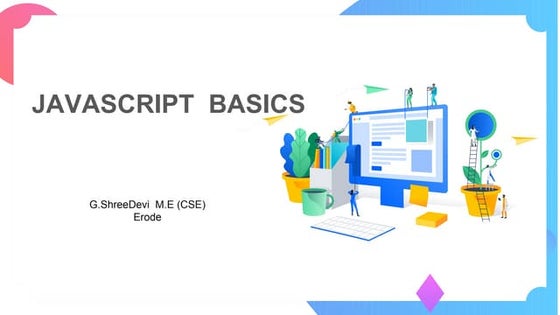



Javascript basicsshreesenthil
?
This document provides an overview of JavaScript basics including variables, data types, operators, conditional statements, loops, functions, arrays, and error handling. It explains JavaScript syntax, how to include JavaScript code in HTML pages, and commonly used statements like if/else, switch case, while and for loops. It also covers JavaScript functions, returning values from functions, and printing pages. The document describes JavaScript strings and array objects, and their associated methods. Finally, it discusses different types of errors in JavaScript like syntax errors, runtime errors, and logical errors.Introduction to Javascript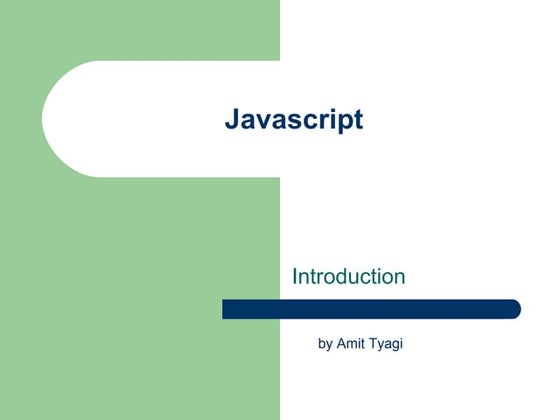



Introduction to JavascriptAmit Tyagi
?
Video links: Part 1 : http://www.youtube.com/watch?v=lWSV4JLLJ8E Part2 : http://www.youtube.com/watch?v=-MvSBqPlMdYNode.js Express



Node.js ExpressEyal Vardi
?
The document discusses Node.js and Express.js concepts for building web servers and applications. It includes examples of creating HTTP servers, routing requests, using middleware, handling errors, templating with views and layouts, and separating code into models and routes.jQuery



jQueryJay Poojara
?
JQuery is a JavaScript library that simplifies HTML document manipulation, event handling, animations, and Ajax interactions. It works across browsers and makes tasks like DOM traversal and manipulation, event handling, animation, and Ajax much simpler. JQuery's versatility, extensibility, and cross-browser compatibility have made it popular, with millions of developers using it to write JavaScript.jQuery



jQueryMostafa Bayomi
?
This document discusses jQuery, a JavaScript library. It defines jQuery as a lightweight library that allows developers to "write less, do more". It describes how jQuery works by selecting elements and running functions on them. It also covers various jQuery methods for DOM manipulation like fading, sliding, and handling events. Key points covered include selecting elements, jQuery syntax, downloading jQuery, and how to get started with basic functionality.React js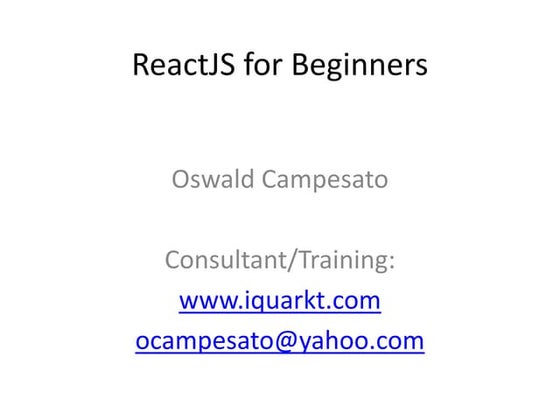



React jsOswald Campesato
?
ReactJS for Beginners provides an overview of ReactJS including what it is, advantages, disadvantages, typical setup tools, and examples of basic React code. Key points covered include:
- ReactJS is a JavaScript library for building user interfaces and is component-based.
- Advantages include high efficiency, easier JavaScript via JSX, good developer tools and SEO, and easy testing.
- Disadvantages include React only handling the view layer and requiring other libraries for full MVC functionality.
- Examples demonstrate basic components, properties, events, conditional rendering, and lists in ReactJS.JavaScript guide 2020 Learn JavaScript



JavaScript guide 2020 Learn JavaScriptLaurence Svekis ?
?
Over 200 Pages of resources and code snippets to learn JavaScript and JavaScript DOM manipulation. JavaScript is the most popular web programming language and this eBook will help you learn more about JavaScript CodingLab #2: Introduction to Javascript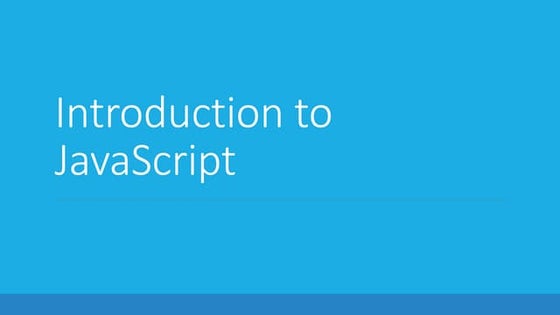



Lab #2: Introduction to JavascriptWalid Ashraf
?
This document provides an introduction to JavaScript and its uses for web programming. It explains that JavaScript is a client-side scripting language that allows web pages to become interactive. Some key points covered include:
- JavaScript can change HTML content, styles, validate data, and make calculations.
- Functions are blocks of code that perform tasks when invoked by events or called in code.
- Events like clicks or keyboard presses trigger JavaScript code.
- The DOM (Document Object Model) represents an HTML document that JavaScript can access and modify.
- Forms and user input can be accessed and processed using the DOM.
- Programming flow can be controlled with conditional and loop statements.
-JavaScript: Events Handling



JavaScript: Events HandlingYuriy Bezgachnyuk
?
The document discusses JavaScript events and event handling. It covers the different phases of events, how to define event handlers, the event object, and how to cancel bubbling and override default browser actions. It also provides examples of handling mouse and keyboard events, such as changing an element's style on mouseover and logging key events.Javascript



JavascriptNagarajan
?
JavaScript is a scripting language that allows adding interactivity to HTML pages. It can be used for client-side form validation and integration with user plugins. JavaScript is case-sensitive and allows variables, functions, conditional statements, and objects. Common uses include pop-up boxes, event handling, and cookies.Javascript



Javascriptguest03a6e6
?
The JavaScript programming language is a multi-paradigm language that is misunderstood due to its name, design errors in early implementations, and use in web browsers. It is a functional language that uses objects, prototypes, and closures. Values in JavaScript include numbers, strings, Booleans, objects, null, and undefined. All other values are objects.An Introduction to the DOM



An Introduction to the DOMMindy McAdams
?
If you are using jQuery, you need to understand the Document Object Model and how it accounts for all the elements inside any HTML document or Web page. jQuery Tutorial For Beginners | Developing User Interface (UI) Using jQuery |...



jQuery Tutorial For Beginners | Developing User Interface (UI) Using jQuery |...Edureka!
?
( ** Full Stack Masters Training: https://www.edureka.co/masters-program/full-stack-developer-training ** )
This PPT on jQuery will help you understand the basics of jQuery and you will also be able to create your own program using jQuery by the end of this PPT.
Follow us to never miss an update in the future.
Instagram: https://www.instagram.com/edureka_learning/
Facebook: https://www.facebook.com/edurekaIN/
Twitter: https://twitter.com/edurekain
LinkedIn: https://www.linkedin.com/company/edurekaIntro to HTML and CSS basics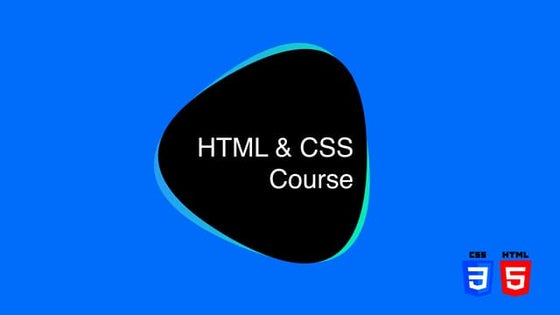



Intro to HTML and CSS basicsEliran Eliassy
?
This document provides an overview of HTML and CSS topics including:
- A brief history of HTML and CSS standards from 1990 to present.
- Descriptions of common HTML elements like <body>, <head>, <img>, <a>, and lists.
- Explanations of CSS concepts like selectors, properties, units, positioning, and layout fundamentals.
- Details on CSS topics like the box model, centering content, semantic HTML, and flexbox.
The document serves as a course outline or reference for learning HTML and CSS fundamentals.Introduction to JavaScript Basics.



Introduction to JavaScript Basics.Hassan Ahmed Baig - Web Developer
?
It is a Very basic introduction to JavaScript. It includes Advantages and Disadvantages of JavaScript, JavaScript Basic Syntax, and JavaScript DOM.Node.js Tutorial for Beginners | Node.js Web Application Tutorial | Node.js T...



Node.js Tutorial for Beginners | Node.js Web Application Tutorial | Node.js T...Edureka!
?
This Edureka "Node.js tutorial" will help you to learn the Node.js fundamentals and how to create an application in Node.js. Node.js is an open-source, cross-platform JavaScript runtime environment for developing a diverse variety of server tools and applications. Below are the topics covered in this tutorial:
1) Client Server Architecture
2) Limitations of Multi-Threaded Model
3) What is Node.js?
4) Features of Node.js
5) Node.js Installation
6) Blocking Vs. Non ¨C Blocking I/O
7) Creating Node.js Program
8) Node.js Modules
9) Demo ¨C Grocery List Web Application using Node.jsReact js programming concept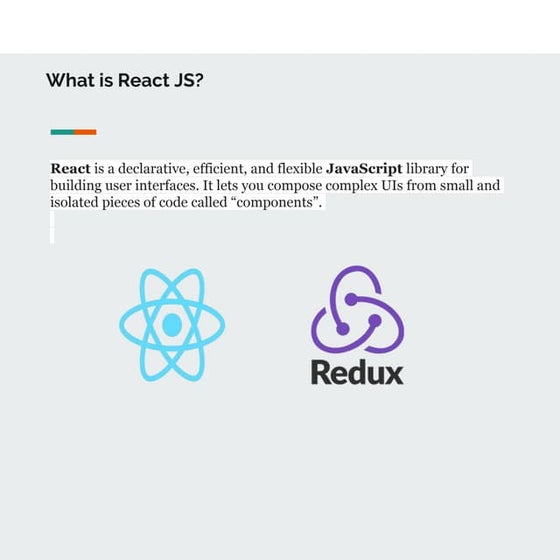



React js programming conceptTariqul islam
?
Provide the primary concept about react js and redux. How react js is integrated with redux to solve the `sate management` for react js application.Javascript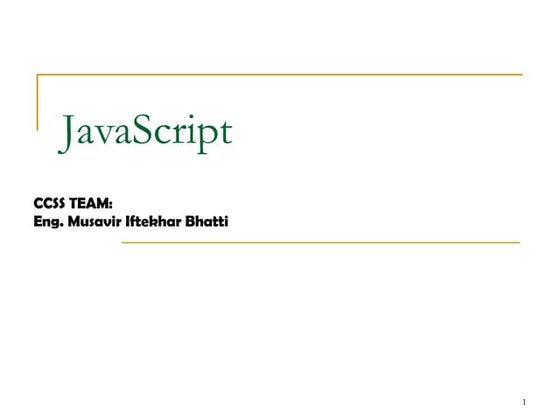



Javascriptmussawir20
?
JavaScript is a client-side scripting language that can be inserted into HTML pages to make them interactive. It allows dynamic validation of forms, changing HTML element properties like visibility, and reacting to user events like clicks or form submissions. The Document Object Model (DOM) represents an HTML or XML document as a tree structure, allowing JavaScript to programmatically access and modify the content, structure, and styling of the document. Common built-in JavaScript objects include String, Date, Array, Math, and Boolean, which provide properties and methods for manipulating text, dates, lists of values, numbers, and true/false values.Java script errors & exceptions handling



Java script errors & exceptions handlingAbhishekMondal42
?
The document discusses JavaScript error and exception handling using try, catch, and finally blocks. It provides examples of using try and catch to handle exceptions, catch to retrieve error details, and finally to execute code regardless of exceptions. It also shows how to use window.onerror to handle uncaught exceptions and access error details.TypeScript



TypeScriptSaray Chak
?
TypeScript adds types to JavaScript to improve scalability and avoid bugs. It supports features like classes, interfaces, generics and enums. Companies use TypeScript for its type safety and ability to write future JavaScript features now. The presentation introduces TypeScript basics like installation, types, functions and classes, and how it helps scale apps and catch errors earlier.Advanced Javascript



Advanced JavascriptAdieu
?
The document discusses different approaches to object-oriented programming in JavaScript, including classical and prototypal inheritance, constructor functions, and the prototype property. It explains how prototypal inheritance works by linking objects together through their internal prototype properties. Constructor functions and the new operator allow simulating classical inheritance by establishing prototype links. Various design patterns are also covered, such as public/privileged methods, singletons, modules, and parasitic inheritance.React JS - Introduction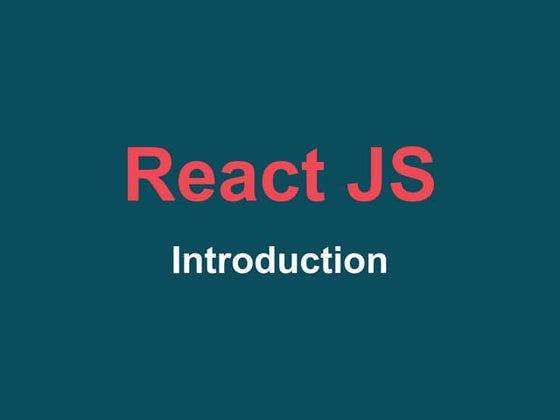



React JS - IntroductionSergey Romaneko
?
React is a JavaScript library created by Facebook and Instagram to build user interfaces. It allows developers to create fast user interfaces easily through components. React uses a virtual DOM to update the real DOM efficiently. Some major companies that use React include Facebook, Yahoo!, Airbnb, and Instagram. React is not a complete framework but rather just handles the view layer. It uses a one-way data binding model and components to build user interfaces.ReactJS presentation.pptx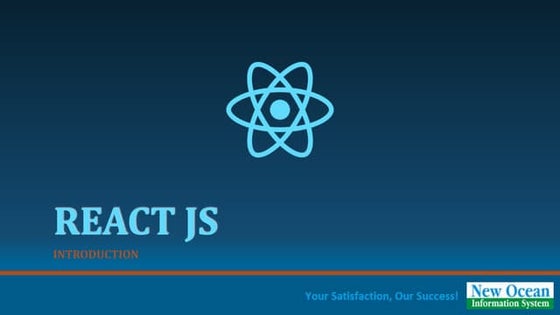



ReactJS presentation.pptxDivyanshGupta922023
?
React JS is a JavaScript library for building user interfaces. It uses virtual DOM and one-way data binding to render components efficiently. Everything in React is a component - they accept custom inputs called props and control the output display through rendering. Components can manage private state and update due to props or state changes. The lifecycle of a React component involves initialization, updating due to state/prop changes, and unmounting from the DOM. React promotes unidirectional data flow and single source of truth to make views more predictable and easier to debug.Java script



Java scriptSadeek Mohammed
?
This document provides an introduction and overview of JavaScript. It discusses that JavaScript is a client-side scripting language that can be inserted into HTML pages and run by web browsers to provide interactive and dynamic features. It covers JavaScript basics like data types, variables, operators, functions, and events. It also explains how to write JavaScript code directly in HTML pages or externally and shows examples of built-in functions and how to create user-defined functions.Introduction to React JS for beginners 



Introduction to React JS for beginners Varun Raj
?
- React is a JavaScript library for building user interfaces that uses a virtual DOM for faster re-rendering on state changes.
- Everything in React is a component that can have states, props, and lifecycle methods like render(). Components return JSX elements.
- Props are used for passing data to components in a unidirectional flow, while states allow components to re-render on changes.
- The render() method returns the view, accessing props and state values. Forms and events also follow React conventions.Javascript: Ajax & DOM Manipulation v1.2



Javascript: Ajax & DOM Manipulation v1.2borkweb
?
This is just a slight revamp of my previous slide on this topic.jQuery



jQueryVishwa Mohan
?
This document provides an introduction and overview of jQuery. It discusses how jQuery simplifies DOM navigation and manipulation, handles browser differences, and makes JavaScript coding easier. The document covers basic jQuery concepts like selectors, the jQuery function, attributes, and events. It also provides examples of common jQuery code.More Related Content
What's hot (20)
React js



React jsOswald Campesato
?
ReactJS for Beginners provides an overview of ReactJS including what it is, advantages, disadvantages, typical setup tools, and examples of basic React code. Key points covered include:
- ReactJS is a JavaScript library for building user interfaces and is component-based.
- Advantages include high efficiency, easier JavaScript via JSX, good developer tools and SEO, and easy testing.
- Disadvantages include React only handling the view layer and requiring other libraries for full MVC functionality.
- Examples demonstrate basic components, properties, events, conditional rendering, and lists in ReactJS.JavaScript guide 2020 Learn JavaScript



JavaScript guide 2020 Learn JavaScriptLaurence Svekis ?
?
Over 200 Pages of resources and code snippets to learn JavaScript and JavaScript DOM manipulation. JavaScript is the most popular web programming language and this eBook will help you learn more about JavaScript CodingLab #2: Introduction to Javascript



Lab #2: Introduction to JavascriptWalid Ashraf
?
This document provides an introduction to JavaScript and its uses for web programming. It explains that JavaScript is a client-side scripting language that allows web pages to become interactive. Some key points covered include:
- JavaScript can change HTML content, styles, validate data, and make calculations.
- Functions are blocks of code that perform tasks when invoked by events or called in code.
- Events like clicks or keyboard presses trigger JavaScript code.
- The DOM (Document Object Model) represents an HTML document that JavaScript can access and modify.
- Forms and user input can be accessed and processed using the DOM.
- Programming flow can be controlled with conditional and loop statements.
-JavaScript: Events Handling



JavaScript: Events HandlingYuriy Bezgachnyuk
?
The document discusses JavaScript events and event handling. It covers the different phases of events, how to define event handlers, the event object, and how to cancel bubbling and override default browser actions. It also provides examples of handling mouse and keyboard events, such as changing an element's style on mouseover and logging key events.Javascript



JavascriptNagarajan
?
JavaScript is a scripting language that allows adding interactivity to HTML pages. It can be used for client-side form validation and integration with user plugins. JavaScript is case-sensitive and allows variables, functions, conditional statements, and objects. Common uses include pop-up boxes, event handling, and cookies.Javascript



Javascriptguest03a6e6
?
The JavaScript programming language is a multi-paradigm language that is misunderstood due to its name, design errors in early implementations, and use in web browsers. It is a functional language that uses objects, prototypes, and closures. Values in JavaScript include numbers, strings, Booleans, objects, null, and undefined. All other values are objects.An Introduction to the DOM



An Introduction to the DOMMindy McAdams
?
If you are using jQuery, you need to understand the Document Object Model and how it accounts for all the elements inside any HTML document or Web page. jQuery Tutorial For Beginners | Developing User Interface (UI) Using jQuery |...



jQuery Tutorial For Beginners | Developing User Interface (UI) Using jQuery |...Edureka!
?
( ** Full Stack Masters Training: https://www.edureka.co/masters-program/full-stack-developer-training ** )
This PPT on jQuery will help you understand the basics of jQuery and you will also be able to create your own program using jQuery by the end of this PPT.
Follow us to never miss an update in the future.
Instagram: https://www.instagram.com/edureka_learning/
Facebook: https://www.facebook.com/edurekaIN/
Twitter: https://twitter.com/edurekain
LinkedIn: https://www.linkedin.com/company/edurekaIntro to HTML and CSS basics



Intro to HTML and CSS basicsEliran Eliassy
?
This document provides an overview of HTML and CSS topics including:
- A brief history of HTML and CSS standards from 1990 to present.
- Descriptions of common HTML elements like <body>, <head>, <img>, <a>, and lists.
- Explanations of CSS concepts like selectors, properties, units, positioning, and layout fundamentals.
- Details on CSS topics like the box model, centering content, semantic HTML, and flexbox.
The document serves as a course outline or reference for learning HTML and CSS fundamentals.Introduction to JavaScript Basics.



Introduction to JavaScript Basics.Hassan Ahmed Baig - Web Developer
?
It is a Very basic introduction to JavaScript. It includes Advantages and Disadvantages of JavaScript, JavaScript Basic Syntax, and JavaScript DOM.Node.js Tutorial for Beginners | Node.js Web Application Tutorial | Node.js T...



Node.js Tutorial for Beginners | Node.js Web Application Tutorial | Node.js T...Edureka!
?
This Edureka "Node.js tutorial" will help you to learn the Node.js fundamentals and how to create an application in Node.js. Node.js is an open-source, cross-platform JavaScript runtime environment for developing a diverse variety of server tools and applications. Below are the topics covered in this tutorial:
1) Client Server Architecture
2) Limitations of Multi-Threaded Model
3) What is Node.js?
4) Features of Node.js
5) Node.js Installation
6) Blocking Vs. Non ¨C Blocking I/O
7) Creating Node.js Program
8) Node.js Modules
9) Demo ¨C Grocery List Web Application using Node.jsReact js programming concept



React js programming conceptTariqul islam
?
Provide the primary concept about react js and redux. How react js is integrated with redux to solve the `sate management` for react js application.Javascript



Javascriptmussawir20
?
JavaScript is a client-side scripting language that can be inserted into HTML pages to make them interactive. It allows dynamic validation of forms, changing HTML element properties like visibility, and reacting to user events like clicks or form submissions. The Document Object Model (DOM) represents an HTML or XML document as a tree structure, allowing JavaScript to programmatically access and modify the content, structure, and styling of the document. Common built-in JavaScript objects include String, Date, Array, Math, and Boolean, which provide properties and methods for manipulating text, dates, lists of values, numbers, and true/false values.Java script errors & exceptions handling



Java script errors & exceptions handlingAbhishekMondal42
?
The document discusses JavaScript error and exception handling using try, catch, and finally blocks. It provides examples of using try and catch to handle exceptions, catch to retrieve error details, and finally to execute code regardless of exceptions. It also shows how to use window.onerror to handle uncaught exceptions and access error details.TypeScript



TypeScriptSaray Chak
?
TypeScript adds types to JavaScript to improve scalability and avoid bugs. It supports features like classes, interfaces, generics and enums. Companies use TypeScript for its type safety and ability to write future JavaScript features now. The presentation introduces TypeScript basics like installation, types, functions and classes, and how it helps scale apps and catch errors earlier.Advanced Javascript



Advanced JavascriptAdieu
?
The document discusses different approaches to object-oriented programming in JavaScript, including classical and prototypal inheritance, constructor functions, and the prototype property. It explains how prototypal inheritance works by linking objects together through their internal prototype properties. Constructor functions and the new operator allow simulating classical inheritance by establishing prototype links. Various design patterns are also covered, such as public/privileged methods, singletons, modules, and parasitic inheritance.React JS - Introduction



React JS - IntroductionSergey Romaneko
?
React is a JavaScript library created by Facebook and Instagram to build user interfaces. It allows developers to create fast user interfaces easily through components. React uses a virtual DOM to update the real DOM efficiently. Some major companies that use React include Facebook, Yahoo!, Airbnb, and Instagram. React is not a complete framework but rather just handles the view layer. It uses a one-way data binding model and components to build user interfaces.ReactJS presentation.pptx



ReactJS presentation.pptxDivyanshGupta922023
?
React JS is a JavaScript library for building user interfaces. It uses virtual DOM and one-way data binding to render components efficiently. Everything in React is a component - they accept custom inputs called props and control the output display through rendering. Components can manage private state and update due to props or state changes. The lifecycle of a React component involves initialization, updating due to state/prop changes, and unmounting from the DOM. React promotes unidirectional data flow and single source of truth to make views more predictable and easier to debug.Java script



Java scriptSadeek Mohammed
?
This document provides an introduction and overview of JavaScript. It discusses that JavaScript is a client-side scripting language that can be inserted into HTML pages and run by web browsers to provide interactive and dynamic features. It covers JavaScript basics like data types, variables, operators, functions, and events. It also explains how to write JavaScript code directly in HTML pages or externally and shows examples of built-in functions and how to create user-defined functions.Introduction to React JS for beginners 



Introduction to React JS for beginners Varun Raj
?
- React is a JavaScript library for building user interfaces that uses a virtual DOM for faster re-rendering on state changes.
- Everything in React is a component that can have states, props, and lifecycle methods like render(). Components return JSX elements.
- Props are used for passing data to components in a unidirectional flow, while states allow components to re-render on changes.
- The render() method returns the view, accessing props and state values. Forms and events also follow React conventions.Similar to JavaScript: Ajax & DOM Manipulation (20)
Javascript: Ajax & DOM Manipulation v1.2



Javascript: Ajax & DOM Manipulation v1.2borkweb
?
This is just a slight revamp of my previous slide on this topic.jQuery



jQueryVishwa Mohan
?
This document provides an introduction and overview of jQuery. It discusses how jQuery simplifies DOM navigation and manipulation, handles browser differences, and makes JavaScript coding easier. The document covers basic jQuery concepts like selectors, the jQuery function, attributes, and events. It also provides examples of common jQuery code.Javascript 2009



Javascript 2009borkweb
?
JavaScript is a client-side scripting language that is commonly used to add interactivity to web pages. The Document Object Model (DOM) represents the structure of an HTML/XML document and allows JavaScript to dynamically access and update the content, structure, and styling of a document. Asynchronous JavaScript and XML (AJAX) is a set of web development techniques that allow web pages to be updated asynchronously by exchanging data with a web server behind the scenes, without reloading the entire page. jQuery is a popular JavaScript library that simplifies tasks like HTML document traversal and manipulation, events, animations, and Ajax interactions for rapid web development.J Query Public



J Query Publicpradeepsilamkoti
?
This document provides an overview of AJAX, JSON, jQuery, and livequery. It discusses how these technologies enable asynchronous communication with servers and manipulation of web pages. It also provides examples of using jQuery to select elements, modify attributes and styles, handle events, and perform animations. The document concludes with assignments for demonstrating skills with jQuery selectors, effects, and calendar functionality.Intro to jQuery



Intro to jQueryAlan Hecht
?
This document provides an introduction and overview of jQuery, including:
1) The benefits of jQuery such as its shallow learning curve, ease of DOM manipulation, cross-browser compatibility, and extensibility through plugins.
2) How to get started with jQuery by downloading the library and using basic selectors and functions.
3) Examples of jQuery selectors, actions, and effects that can be used to manipulate and style page elements.
4) Important jQuery concepts like the DOM, CSS selectors, JSON, and using events like "ready" and "click" to execute code.Jquery fundamentals



Jquery fundamentalsSalvatore Fazio
?
The document discusses jQuery fundamentals including selectors, interacting with the DOM, handling events, and Ajax features. It provides examples and recommendations for learning jQuery including reading documentation, using tools like VSDoc and Fiddler, and consuming tea and beer. Next steps mentioned are exploring additional JavaScript libraries and frameworks like Knockout, Backbone, LINQ.js, TypeScript, and SignalR to build richer user interfaces.eXo SEA - JavaScript Introduction Training



eXo SEA - JavaScript Introduction TrainingHoat Le
?
Javascript allows interactive content on web pages and control of the browser and document. It is an interpreted scripting language that is cross-platform but support varies. Javascript can provide interactive content, control document appearance and content, and interact with the user through event handlers.Don't Worry jQuery is very Easy:Learning Tips For jQuery



Don't Worry jQuery is very Easy:Learning Tips For jQueryshabab shihan
?
If for whatever reason you donˇŻt know jQuery, it is a ˇ°write less, do moreˇ± JavaScript library. It has many Ajax and JavaScript features to allow you enhance semantic coding and user experience.22 j query1



22 j query1Fajar Baskoro
?
jQuery is a JavaScript library that simplifies HTML document traversal, event handling, animating, and Ajax interactions. It allows you to write less code that does more. jQuery selects DOM elements using CSS-style selectors and provides methods for traversing, manipulating, and animating elements. Some key benefits of jQuery include writing concise code, cross-browser compatibility, and a large ecosystem of plugins.Javascript Templating



Javascript Templatingbcruhl
?
This was a presentation I wrote for a previous employer, aimed at Java developers. The goal was to help them understand some of the new UI conventions I was putting into their application, so that they would be able to develop "smarter" JSP code.J query1



J query1Manav Prasad
?
This document provides an overview of jQuery, including:
- jQuery is a JavaScript library that simplifies HTML document traversal, event handling, animating, and Ajax interactions.
- jQuery allows developers to write less code and do more, with features like simplified DOM manipulation and CSS selection.
- The document demonstrates basic jQuery concepts like DOM selection, traversal, and manipulation using jQuery's CSS selector syntax and methods.jQuery Fundamentals



jQuery FundamentalsDoncho Minkov
?
This document provides a summary of jQuery fundamentals, including:
- jQuery simplifies client-side scripting of HTML and selecting DOM elements
- Popular uses include navigation, animation, event handling, and AJAX
- jQuery is easy to learn and use, supports method chaining, and has a large developer community
- Key concepts include selecting elements, DOM manipulation, events, AJAX requests, and using jQuery UI widgetsJavaScript & Dom Manipulation



JavaScript & Dom ManipulationMohammed Arif
?
JavaScript can dynamically manipulate the content, structure, and styling of an HTML document through the Document Object Model (DOM). The DOM represents an HTML document as nodes that can be accessed and modified with JavaScript. Common tasks include dynamically creating and adding elements, handling user events like clicks, and updating content by accessing DOM elements by their id or other attributes.JQuery_and_Ajax.pptx



JQuery_and_Ajax.pptxAditiPawale1
?
The document discusses jQuery and Ajax. It explains that jQuery is a JavaScript library that simplifies JavaScript programming and DOM manipulation. It allows selecting HTML elements and performing actions on them with simple syntax like $(selector).action(). Some key points made are:
- jQuery takes common tasks like AJAX calls and wraps them in simple methods.
- Popular features include HTML/CSS manipulation, events, effects/animations, and utilities.
- Major companies like Google use jQuery.
- jQuery works cross-browser and is easy to include via a script tag.J Query(04 12 2008) Foiaz



J Query(04 12 2008) Foiaztestingphase
?
The document provides an overview of jQuery, including what it is, its syntax, basic usage, selectors, filters, events, and effects. jQuery is a powerful JavaScript library that simplifies common JavaScript tasks like selecting elements, modifying CSS, handling events, and animations. It provides cross-browser compatibility and AJAX support. jQuery selectors and methods allow selecting and manipulating page elements via CSS-like syntax.Week 4 - jQuery + Ajax



Week 4 - jQuery + Ajaxbaygross
?
This document provides an introduction to jQuery, including what jQuery is, why it's useful, how to include it, and some common jQuery syntax and methods. Key points:
- jQuery is a JavaScript framework that makes interacting with HTML, CSS, and browser functionality simpler. It provides methods for DOM manipulation, AJAX requests, and event handling.
- jQuery uses CSS selector syntax to select elements and chainable methods to manipulate them. Common methods include show(), hide(), addClass(), removeClass(), and more.
- Events like click and change can have callback functions attached via jQuery. AJAX requests allow asynchronous data retrieval without page reloads.
- jQuery handles cross-browser compatibility and provides a consistentIntroduction to Prototype JS Framework



Introduction to Prototype JS FrameworkMohd Imran
?
Prototype JS is a JavaScript framework that simplifies DOM manipulation, AJAX requests, and other common tasks. It provides functions for DOM traversal and manipulation, event handling, effects and animations, forms, JSON, and more. Developers use Prototype to build dynamic web pages and applications with less code and cross-browser compatibility.Jquery Complete Presentation along with Javascript Basics



Jquery Complete Presentation along with Javascript BasicsEPAM Systems
?
jQuery is a JavaScript library that simplifies HTML document manipulation and event handling. It allows developers to select elements, hide/show elements, and handle events with simple and concise code. jQuery animations and effects like fade, slide, and animate allow for creative transitions between states.Introduction to JQuery



Introduction to JQueryMuhammad Afzal Qureshi
?
jQuery is a JavaScript library that makes it easier to write JavaScript code that runs on different browsers. It allows selecting DOM elements, traversing through them and manipulating them. jQuery simplifies tasks like handling events, animating elements, and making AJAX calls. Some key features include selecting elements by tag name, ID, or CSS class; traversing DOM elements; binding event handlers; animating elements with effects like show, hide, fade; and making asynchronous HTTP requests via AJAX.Think jQuery



Think jQueryYing Zhang
?
jQuery is a JavaScript library that allows developers to write less code and do more. It provides a simplified syntax for DOM manipulation and event handling. jQuery works across browsers and integrates well with other JavaScript libraries. Its selector syntax is based on CSS and it supports chaining of methods. jQuery helps developers write unobtrusive JavaScript code that is cleaner and more maintainable.Recently uploaded (20)
UiPath NY AI Series: Session 4: UiPath AutoPilot for Developers using Studio Web



UiPath NY AI Series: Session 4: UiPath AutoPilot for Developers using Studio WebDianaGray10
?
Welcome to session 4 of the UiPath AI series. In this session, you will learn about UiPath Autopilot for Developers using Studio Web.The Rise of AI Agents-From Automation to Autonomous Technology



The Rise of AI Agents-From Automation to Autonomous TechnologyImpelsys Inc.
?
AI agents are more than just a buzzwordˇŞthey are transforming industries with real autonomy. Unlike traditional AI, they donˇŻt just follow commands; they think, adapt, and act independently. The future isnˇŻt just AI-enabledˇŞitˇŻs AI-powered. How Air Coil Inductors Work By Cet Technology



How Air Coil Inductors Work By Cet TechnologyCET Technology
?
Air coil inductors are coils of conducting wire wound around a non-magnetic core, typically plastic, ceramic, or an air-filled form. These inductors don't rely on a magnetic core made of permeable materials like traditional inductors. The coil consists of a wire wound around a non-magnetic form, where air is the primary medium between the windings.Presentation Session 2 -Context Grounding.pdf



Presentation Session 2 -Context Grounding.pdfMukesh Kala
?
This series is your gateway to understanding the WHY, HOW, and WHAT of this revolutionary technology. Over six interesting sessions, we will learn about the amazing power of agentic automation. We will give you the information and skills you need to succeed in this new era.Sugarlab AI: How Much Does an XXX AI Porn Generator Cost in 2025



Sugarlab AI: How Much Does an XXX AI Porn Generator Cost in 2025Sugarlab AI
?
The cost of an XXX AI porn generator in 2025 varies depending on factors like AI sophistication, subscription plans, and additional expenses. Whether you're looking for a free AI porn video generator or a premium adult AI image generator, pricing ranges from basic tools to enterprise-level solutions. This article breaks down the costs, features, and what to expect from AI-driven adult content platforms.The Road to SAP S4HANA Cloud with SAP Activate.pptx



The Road to SAP S4HANA Cloud with SAP Activate.pptxzsbaranyai
?
Road to SAP S4HANA Cloud with SAP ActivateWindows Client Privilege Escalation-Shared.pptx



Windows Client Privilege Escalation-Shared.pptxOddvar Moe
?
şÝşÝߣs from the webinar "Windows Client Privilege Escalation"
https://youtu.be/EG2Mbw2DVnU?si=rlx-GG2QMQpIxQYiGenerative AI & Telco track at AMLD 2024



Generative AI & Telco track at AMLD 2024Laurent Ciavaglia
?
Generative AI and Telco track at AMLD 2024UiPath NY AI Series: Session 3: UiPath Autopilot for Everyone with Clipboard AI



UiPath NY AI Series: Session 3: UiPath Autopilot for Everyone with Clipboard AIDianaGray10
?
? Embracing the Future: UiPath NY AI Series ¨C Session 3: UiPath Autopilot for Everyone with Clipboard AI
? Event Overview
This session will provide a deep dive into how UiPath Clipboard AI and Autopilot are reshaping automation, offering attendees a firsthand look at their capabilities, use cases, and real-world benefits. Whether you're a developer, business leader, or automation enthusiast, you'll gain valuable insights into leveraging these AI-driven tools to streamline operations and maximize productivity. ??UiPath Agentic automation with Autopilot for everyone + new features/releases



UiPath Agentic automation with Autopilot for everyone + new features/releasesDianaGray10
?
Explore UiPath Agentic automation with Autopilot for everyone - from quick setup, admin settings to custom tools setup.DraginoĄ×ĄíĄŔĄŻĄČĄ«ĄżĄíĄ° LoRaWAN NB-IoT LTE cat.M1ÉĚĆ·ĄęĄąĄČ



DraginoĄ×ĄíĄŔĄŻĄČĄ«ĄżĄíĄ° LoRaWAN NB-IoT LTE cat.M1ÉĚĆ·ĄęĄąĄČCRI Japan, Inc.
?
DraginoĄ×ĄíĄŔĄŻĄČĄ«ĄżĄíĄ° LoRaWAN NB-IoT LTE cat.M1ÉĚĆ·ĄęĄąĄČI am afraid of no test! The power of BDD



I am afraid of no test! The power of BDDOrtus Solutions, Corp
?
Testing doesn't have to be scary! Testing Paralysis is real! Join us for a deep dive into TestBox, the powerful BDD/TDD testing framework. Learn how to write clean, fluent tests, automate your workflows, and banish bugs with confidence. Whether you're new to testing or a seasoned pro, this session will equip you with the tools to kill off that paralysis and win!
Rens van de Schoot - Mensen, machines en de zoektocht naar het laatste releva...



Rens van de Schoot - Mensen, machines en de zoektocht naar het laatste releva...voginip
?
Keynote bij de VOGIN-IP-lezing, 27 maart 2025, OBA AmsterdamSAP Automation with UiPath: SAP Test Automation - Part 5 of 8



SAP Automation with UiPath: SAP Test Automation - Part 5 of 8DianaGray10
?
This interesting webinar will show how UiPath can change how SAP Test Automation works. It will also show the main benefits and best ways to use UiPath with SAP.
Topics to be covered:
Learn about SAP test automation and why it's important for testing.
UiPath Overview: Learn how UiPath can make your SAP testing easier and faster.
Test Manager: Learn about the key advantages of automating your SAP tests, including increased accuracy and reduced time.
Best Practices: Get practical tips on how to use and improve test automation with UiPath.
Real-World Examples: Demonstration on how organizations have successfully leveraged UiPath for SAP test automation.Columbia Weather Systems - Product Overview



Columbia Weather Systems - Product OverviewColumbia Weather Systems
?
Columbia Weather Systems offers professional weather stations in basically three configurations for industry and government agencies worldwide: Fixed-Base or Fixed-Mount Weather Stations, Portable Weather Stations, and Vehicle-Mounted Weather Stations.
Models include all-in-one sensor configurations as well as modular environmental monitoring systems. Real-time displays include hardware console, WeatherMaster? Software, and a Weather MicroServer? with industrial protocols, web and app monitoring options.
Innovative Weather Monitoring: Trusted by industry and government agencies worldwide. Professional, easy-to-use monitoring options. Customized sensor configurations. One-year warranty with personal technical support. Proven reliability, innovation, and brand recognition for over 45 years.STARLINK-JIO-AIRTEL Security issues to Ponder



STARLINK-JIO-AIRTEL Security issues to Ponderanupriti
?
A news clip from India's number 1 news paper HINDI....in which views shared on JIO-AIRTEL-Starlink security issuesMaking GenAI Work: A structured approach to implementation



Making GenAI Work: A structured approach to implementationJeffrey Funk
?
Richard Self and I present a structured approach to implementing generative AI in your organization, a #technology that sparked the addition of more than ten trillion dollars to market capitalisations of Magnificent Seven (Apple, Amazon, Google, Microsoft, Meta, Tesla, and Nvidia) since January 2023.
Companies must experiment with AI to see if particular use cases can work because AI is not like traditional software that does the same thing over and over again. As Princeton UniversityˇŻs Arvind Narayanan says: ˇ°ItˇŻs more like creative, but unreliable, interns that must be managed in order to improve processes.ˇ±
Graphs & GraphRAG - Essential Ingredients for GenAI



Graphs & GraphRAG - Essential Ingredients for GenAINeo4j
?
Knowledge graphs are emerging as useful and often necessary for bringing Enterprise GenAI projects from PoC into production. They make GenAI more dependable, transparent and secure across a wide variety of use cases. They are also helpful in GenAI application development: providing a human-navigable view of relevant knowledge that can be queried and visualised.
This talk will share up-to-date learnings from the evolving field of knowledge graphs; why more & more organisations are using knowledge graphs to achieve GenAI successes; and practical definitions, tools, and tips for getting started.The Future is Here ¨C Learn How to Get Started! Ionic App Development



The Future is Here ¨C Learn How to Get Started! Ionic App Development7Pillars
?
What is Ionic App Development? ¨C A powerful framework for building high-performance, cross-platform mobile apps with a single codebase.
Key Benefits of Ionic App Development ¨C Cost-effective, fast development, rich UI components, and seamless integration with native features.
Ionic App Development Process ¨C Includes planning, UI/UX design, coding, testing, and deployment for scalable mobile solutions.
Why Choose Ionic for Your Mobile App? ¨C Ionic offers flexibility, native-like performance, and strong community support for modern app development.
Future of Ionic App Development ¨C Continuous updates, strong ecosystem, and growing adoption make Ionic a top choice for hybrid app development.Getting the Best of TrueDEM ¨C April News & Updates



Getting the Best of TrueDEM ¨C April News & Updatespanagenda
?
Webinar Recording: https://www.panagenda.com/webinars/getting-the-best-of-truedem-april-news-updates/
Boost your Microsoft 365 experience with OfficeExpert TrueDEM! Join the April webinar for a deep dive into recent and upcoming features and functionalities of OfficeExpert TrueDEM. WeˇŻll showcase whatˇŻs new and use practical application examples and real-life scenarios, to demonstrate how to leverage TrueDEM to optimize your M365 environment, troubleshoot issues, improve user satisfaction and productivity, and ultimately make data-driven business decisions.
These sessions will be led by our team of product management and consultants, who interact with customers daily and possess in-depth product knowledge, providing valuable insights and expert guidance.
What youˇŻll take away
- Updates & info about the latest and upcoming features of TrueDEM
- Practical and realistic applications & examples for troubelshooting or improving your Microsoft Teams & M365 environment
- Use cases and examples of how our customers use TrueDEMJavaScript: Ajax & DOM Manipulation
- 1. JavaScript Ajax & DOM Manipulation Matthew Batchelder
- 2. Agenda JavaScript: What it is and isn't JavaScript: Uses What is the DOM? What is AJAX? jQuery FTW! Manipulating page elements (the DOM) in sweet ways Simplified AJAX Other Coolness Pluggability jQuery in myPlymouth
- 3. Before We Start! Important tools to have Use Firefox Firebug JS Debugging FTW Web Developer Toolbar (handy) A sexy text editor (not notepad)
- 4. JS: What it is and isnˇŻt NOT Java despite its name ECMAScript More than form validation Client-Side Scripting Language Dynamic Weakly Typed Object-Oriented (Prototype-Based) DOM Event Tool
- 5. JavaScript Sandbox Scripts run in a ˇ°sandboxˇ± Can only perform web-related actions, not File-System actions Constrained by a ˇ°Same Origin Policyˇ±
- 6. JS: Usage Drop this puppy in your page: <html> <head> <title>Example JS Page</title> <script type=ˇ°text/javascriptˇ±> // javascript code goes here </script> </head> <body> ˇ </body> </html>
- 7. JS: Literals The following are literalsˇeach variable is literally the data assigned. <script type=ˇ°text/javascriptˇ±> var myNumber = 123; var myString = ˇ®Bork!ˇŻ; var myBoolean = true; var myFunction = function(){ return ˇ®helloˇŻ;} var myRegExp = /bork/gi; var myArray = [1, 2, 3]; var myCarObject = { color: ˇ®redˇŻ, tires: 4, windows: 6 } </script>
- 8. JS: Objects Everything in JS is an Object Those literals can be written: <script type=ˇ°text/javascriptˇ±> var myNumber = new Number(123); var myString = new String(ˇ®Bork!ˇŻ); var myBoolean = new Boolean(true); var myFunction = new Function(ˇ®ˇŻ, ˇ°return ˇ®helloˇŻˇ±);} var myRegExp = new RegExp(ˇ®borkˇŻ); var myArray = new Array(); myArray[0] = 1; myArray[1] = 2; myArray[2] = 3; var myCarObject = new Object(); myCarObject.color = ˇ®redˇŻ; myCarObject.tires = 4; myCarObject.windows = 6; </script>
- 9. JS: Objects Objects values are accessed using dot (ˇ°.ˇ±) notation: example <html> <head> <title>Examples</title> <script type="text/javascript"> var bork = 'Bork!'; var w00t = { hello: 'Greetings', yo: function(){ alert(bork + ' ' + this.hello); } }; var zomg = { nested: { iMeanReallyNested: { seriously: { out: function(){ alert('whee!'); } } } } }; w00t.yo(); zomg.nested.iMeanReallyNested.seriously.out(); </script> </head> <body> ... </body> </html>
- 10. JS: Control Structures if (bork) { //... } else { //... } while (bork) { //... } for (var i = 0; i< 10; i++) { //... } for (var element in array_of_elements) { //... } do { //... } while (bork); switch (bork) { case 1: // if bork == 1... case 'whee': // if bork == 'whee'... case false: // if bork == false... default : // otherwise ... } try { //... } catch (err) { //... }
- 11. What is the DOM? DOM == Document Object Model The DOM is hierarchical <html> <head> <title>Example JS Page</title> </head> <body> <form id=ˇ°some_formˇ±> <input type=ˇ°textˇ± name=ˇ°borkˇ±/> <input type=ˇ°submitˇ± value=ˇ°Goˇ±/> </form> </body> </html>
- 12. Finding DOM Elements document.getElementById() returns a specific element document.getElementByTag() returns an array of elements
- 13. DOM Element Attributes nodeName nodeValue nodeType parentNode childNodes firstChild lastChild previousSibling nextSibling attributes ownerDocument 1 = an HTML element 2 = an element attribute 3 = text 8 = an HTML comment 9 = a document 10 = a document type definition DOM Attributes Node Types HereˇŻs a good article that uses these.
- 14. Manipulating the DOM Dynamically creating and adding elements document.createElement appendChild example
- 15. innerHTML Why go through the trouble of creating Nodes? More efficient Easier example
- 16. Events Click Dblclick Mousedown Mouseup Mouseover Mousemove Mouseout Keypress Keydown Keyup Select Change Submit Reset Focus Blur Load Unload Abort Error Resize Scroll Mouse Keyboard Frame/Object Form
- 17. Simple Alert Box <html> <head> <title>Example Message Box Page</title> <script type=ˇ°text/javascriptˇ±> alert(ˇ®I like butterˇŻ); </script> </head> <body> ˇ </body> </html>
- 18. Confirm Box Bound to an Event <html> <head> <title>Example Message Box Page</title> <script type="text/javascript"> function doLoad() { document.getElementById('sweet-link').addEventListener(ˇ®clickˇŻ, confirmClick, false); }//end doLoad function confirmClick() { return confirm(ˇ®Are you sure you wish to go to that link?ˇŻ); }//end confirmClick window.addEventListener(ˇ®loadˇŻ, doLoad, false); </script> </head> <body> <a id="sweet-link" href="http://borkweb.com">BorkWeb</a> </body> </html> example
- 19. Hiding/Displaying Elements Element visibility is a nice use of events and DOM manipulation example
- 20. AJAX AJAX (Asychronous Javascript and XML) Gives you the ability to load content dynamically! Loading content on demand Possible usability Issues Possible performance issues and benefits Limitation: the sandbox prevents Cross-Site Ajax
- 21. Ajax: XMLHttpRequest Loading content on demand: example
- 22. WAIT!!!!!!!!!!!!! Things can actually be a bit easier. How much? Well most of the above.
- 23. WTF? jQuery. ThatˇŻs what we use on campus. Its hawt.
- 24. What is jQuery? jQuery is a sweet JavaScript Library Its Mantra: Find stuff and do stuff with it Focuses on simplicity Get it here Check out the docs
- 25. Finding Elements Say goodbye to document.getElementById() and document.getElementByTag() Say hello to: $() Uses CSS Selectors to find elements and returns them as an array of elements.
- 26. Finding Elements With $ $(ˇ®aˇŻ) $(ˇ®.classˇŻ) $(ˇ®#idˇŻ) $(ˇ®.content divˇŻ) $(ˇ®input[name=bork]ˇŻ) $(ˇ®input:firstˇŻ) HereˇŻs an example . Check out the selector syntax for more info.
- 27. Lets do some of the stuff we already didˇ Adding Text Fields Toggling Element Visibility Ajax Content
- 28. jQuery Coolness Browser data $.browser Effects Sliding Fading Animating Chaining $(ˇ®aˇŻ).click(function(){alert(ˇ®helloˇŻ);return false;}).css(ˇ®font-weightˇŻ,ˇŻboldˇŻ).fadeOut(ˇ®slowˇŻ);
- 29. jQuery Plugins Pluggable! Additional jQuery functionality added by including jQuery plugins .
- 30. jQuery in myPlymouth Go Sidebar Bookmarks Tab Stack Etcˇ Check out the source .
- 31. The End. Resources şÝşÝߣ Examples jQuery Image Sprites (I talked about this briefly) Mega Man !